Serving 352 students in grades Prekindergarten-6, Sherman Elementary School ranks in the top 10% of all schools in Virginia for overall test scores (math proficiency is top 10%, and reading proficiency is top 10%).
The percentage of students achieving proficiency in math is 80-84% (which is higher than the Virginia state average of 54%). The percentage of students achieving proficiency in reading/language arts is 85-89% (which is higher than the Virginia state average of 69%).
The student:teacher ratio of 14:1 is equal to the Virginia state level of 14:1.
Minority enrollment is 43% of the student body (majority Asian), which is lower than the Virginia state average of 56% (majority Black and Hispanic).
Quick Stats (2025)
- Grades: Prekindergarten-6
- Enrollment: 352 students
- Student:Teacher Ratio: 14:1
- Minority Enrollment: 43%
- Overall Testing Rank: Top 10% in VA
- Math Proficiency: 80-84% (Top 10%)
- Reading Proficiency: 85-89% (Top 10%)
- Science Proficiency: 70-79% (Top 20%)
- Source: National Center for Education Statistics (NCES), VA Dept. of Education
Top Rankings
Sherman Elementary School ranks among the top 20% of public schools in Virginia for:
Category
Attribute
Overall Rank
Math Proficiency
Reading/Language Arts Proficiency
Science Proficiency
Community Size
School Overview
Sherman Elementary School's student population of 352 students has declined by 10% over five school years.
The teacher population of 26 teachers has declined by 16% over five school years.
Grades Offered
Grades Prekindergarten-6
(offers virtual instruction)
(offers virtual instruction)
Total Students
352 students
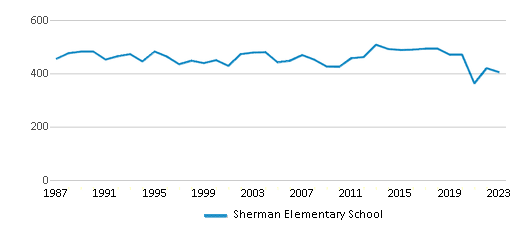
Gender %
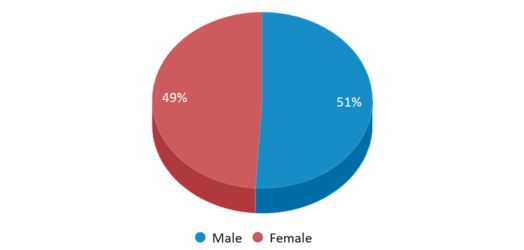
Total Classroom Teachers
26 teachers
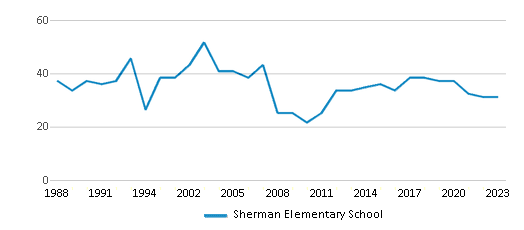
Students by Grade
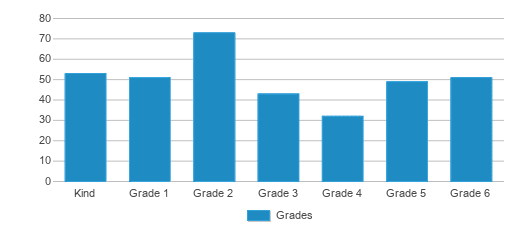
School Rankings
Sherman Elementary School ranks within the top 10% of all 1,792 schools in Virginia (based off of combined math and reading proficiency testing data).
The diversity score of Sherman Elementary School is 0.60, which is less than the diversity score at state average of 0.72. The school's diversity has stayed relatively flat over five school years.
Overall Testing Rank
#103 out of 1792 schools
(Top 10%)
(Top 10%)
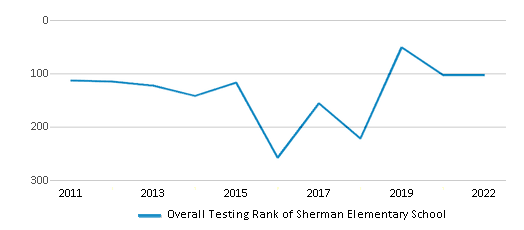
Math Test Scores (% Proficient)
(20-21)80-84%
54%
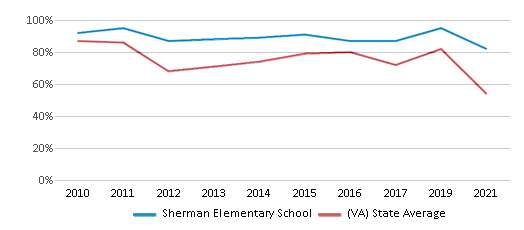
Reading/Language Arts Test Scores (% Proficient)
(20-21)85-89%
69%
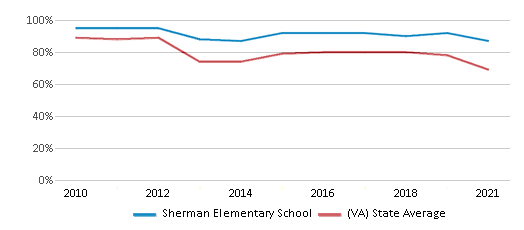
Science Test Scores (% Proficient)
(20-21)70-79%
59%
Student : Teacher Ratio
14:1
14:1
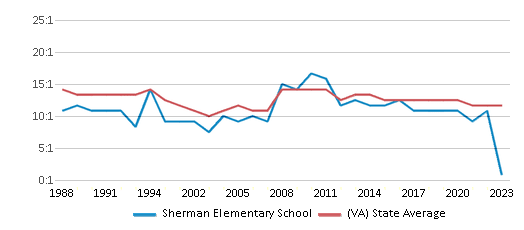
American Indian
n/a
n/a
Asian
26%
8%
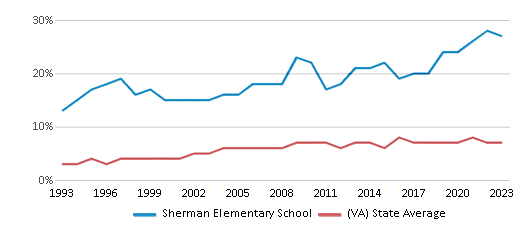
Hispanic
5%
19%
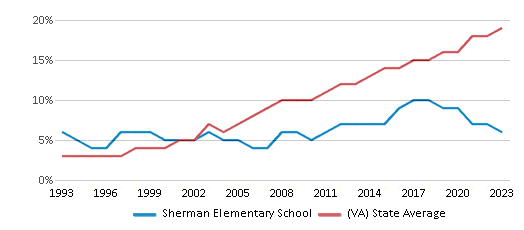
Black
2%
22%
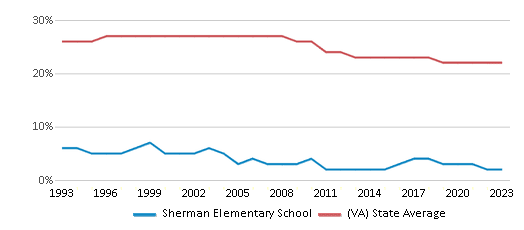
White
57%
44%
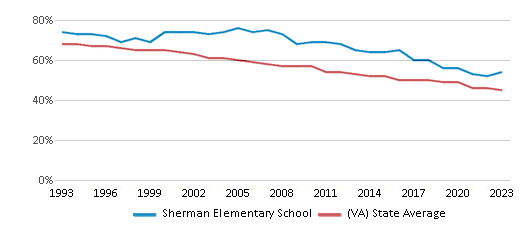
Hawaiian
n/a
n/a
Two or more races
10%
7%
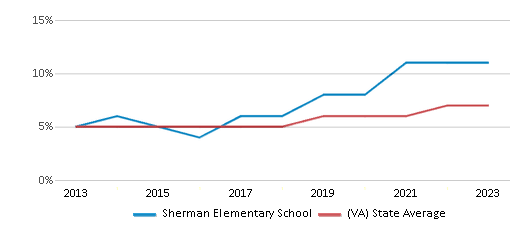
All Ethnic Groups
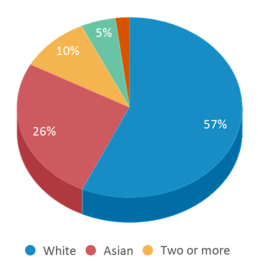
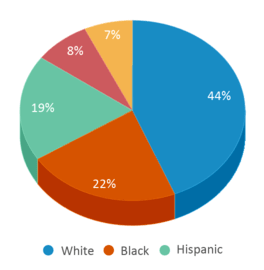
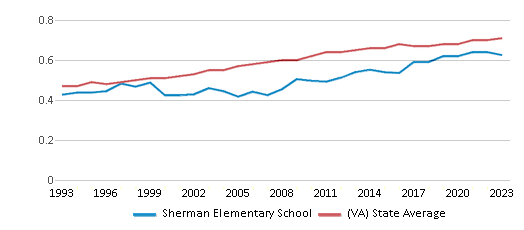
Eligible for Free Lunch
4%
55%
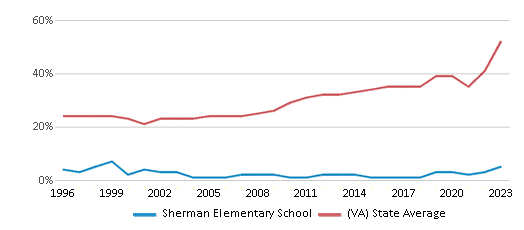
Eligible for Reduced Lunch
1%
2%
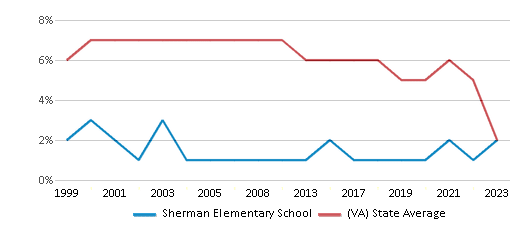
School Statewide Testing
School District Name
Source: National Center for Education Statistics (NCES), VA Dept. of Education
Profile last updated: 02/09/2025
Frequently Asked Questions
What is Sherman Elementary School's ranking?
Sherman Elementary School is ranked #103 out of 1,792 schools, which ranks it among the top 10% of public schools in Virginia.
What schools are Sherman Elementary School often compared to?
Sherman Elementary Schoolis often viewed alongside schools like Kent Gardens Elementary School by visitors of our site.
What percent of students have achieved state testing proficiency in math and reading?
80-84% of students have achieved math proficiency (compared to the 54% VA state average), while 85-89% of students have achieved reading proficiency (compared to the 69% VA state average).
How many students attend Sherman Elementary School?
352 students attend Sherman Elementary School.
What is the racial composition of the student body?
57% of Sherman Elementary School students are White, 26% of students are Asian, 10% of students are Two or more races, 5% of students are Hispanic, and 2% of students are Black.
What is the student:teacher ratio of Sherman Elementary School?
Sherman Elementary School has a student ration of 14:1, which is equal to the Virginia state average of 14:1.
What grades does Sherman Elementary School offer ?
Sherman Elementary School offers enrollment in grades Prekindergarten-6 (offers virtual instruction).
What school district is Sherman Elementary School part of?
Sherman Elementary School is part of Fairfax County School District.
School Reviews
5 6/13/2011
Great little school. Very highly recommend. Test scores are really high. The school has an active PTA and there is a lot of parent involvement, because McLean is a wealthy suburb with a lot of parents who have graduate degrees and professional jobs. The building just was renovated in 2009. The teachers are excellent, although there has been huge teacher turnover in the last few years. One downside is the school sometimes has to have split classes because it's such a small school. Usually they have 2 classes of each grade, but sometimes there will be a 4th and 5th grade combined class where 1 teacher teaches both grades in the same classroom, along with one 4th grade-only class and one 5th grade-only class. Some kids do fine with that but others do not, so some parents do not like split classes. Also, the Franklin Sherman students who qualify for GT (Gifted and Talented program) go to the Haycock Elementary school starting in 3rd grade. Franklin Sherman still has a GT enrichment teacher, but budget cuts have forced them to reduce her hours.
Review Sherman Elementary School. Reviews should be a few sentences in length. Please include any comments on:
- Quality of academic programs, teachers, and facilities
- Availability of music, art, sports and other extracurricular activities
Recent Articles

What Is A Charter School?
Explore the world of charter schools in this comprehensive guide. Learn about their history, how they operate, and the pros and cons of this educational innovation. Discover key facts about charter schools, including admission policies, demographics, and funding, as well as what to look for when considering a charter school for your child.

10 Reasons Why High School Sports Benefit Students
Discover the 10 compelling reasons why high school sports are beneficial for students. This comprehensive article explores how athletics enhance academic performance, foster personal growth, and develop crucial life skills. From improved fitness and time management to leadership development and community representation, learn why participating in high school sports can be a game-changer for students' overall success and well-being.

February 05, 2025
Understanding the U.S. Department of Education: Structure, Impact, and EvolutionWe explore how the Department of Education shapes American education, from its cabinet-level leadership to its impact on millions of students, written for general audiences seeking clarity on this vital institution.





